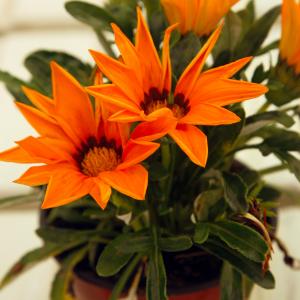文章
Dummer. ゛☀
2017年09月30日

Gazania is a genus of low-growing, trailing ground covers with daisy-like blooms that open on summer and fall days, closing at night. It only grows 0.5 to 1 foot (15 to 30 cm) tall and 1 to 2 feet (30 to 60 cm) wide, but its vivid flowers more than make up for its lack of height. Although grown as an annual in much of the country, this plant overwinters in U.S. Department of Agriculture plant hardiness zones 8b through 11. Plant this colorful, low-growing specimen outside in containers or directly into the ground to incorporate it into your landscape.
Growing Conditions and General Care
Plant Gazanias in early spring, in full sun and well-draining soil, spacing multiple plants 12 to 18 inches (30 to 45 cm) apart to form a ground cover mat. These flowers can tolerate almost any type of soil — alkaline, acidic, loam, clay and sand — as long as they have good drainage, though they prefer good, fertile loam.
Water the Gazania, keeping it moist after planting until you see new growth. Once growing on its own, this plant is quite drought tolerant, and only requires supplemental water during droughts of three weeks or more. Water in the morning, as Gazanias can succumb to stem and root rots, powdery mildew and leaf spot that can result from staying wet for too long.
Pinch off fading flowers with your fingers to encourage a longer bloom period.
Prune annually in late winter or early spring, beginning in the second season, cutting the foliage back to 2 or 3 inches above the ground with pruning shears. This will refresh the plant and encourage new growth.
Fertilize annually soon after pruning, beginning in the second season, with a teaspoon or two of 10-10-10 granular fertilizer, scattering it evenly around the edges of the plant and watering it into the ground. Gazanias can tolerate soils with low fertility, and actually do not do well with excess fertilizer. In even moderately fertile soil they do not require this application, but it can encourage healthy early season growth.
Plant different varieties of Gazanias in a bunch for a colorful mix.
Propagation
Gazanias are particularly suited for creating a fast-spreading garden spread. They self-seed and grow very quickly. However, you can fasten the propagation process. For this, systematic division of young Gazanias is needed. Choose Gazanias that are about 10 inches (25 cm) tall. Using gardening scissors, cut through the basal stem, dividing it into two halves. Each half will now grow as an individual plant.

Growing Conditions and General Care
Plant Gazanias in early spring, in full sun and well-draining soil, spacing multiple plants 12 to 18 inches (30 to 45 cm) apart to form a ground cover mat. These flowers can tolerate almost any type of soil — alkaline, acidic, loam, clay and sand — as long as they have good drainage, though they prefer good, fertile loam.

Water the Gazania, keeping it moist after planting until you see new growth. Once growing on its own, this plant is quite drought tolerant, and only requires supplemental water during droughts of three weeks or more. Water in the morning, as Gazanias can succumb to stem and root rots, powdery mildew and leaf spot that can result from staying wet for too long.
Pinch off fading flowers with your fingers to encourage a longer bloom period.

Prune annually in late winter or early spring, beginning in the second season, cutting the foliage back to 2 or 3 inches above the ground with pruning shears. This will refresh the plant and encourage new growth.
Fertilize annually soon after pruning, beginning in the second season, with a teaspoon or two of 10-10-10 granular fertilizer, scattering it evenly around the edges of the plant and watering it into the ground. Gazanias can tolerate soils with low fertility, and actually do not do well with excess fertilizer. In even moderately fertile soil they do not require this application, but it can encourage healthy early season growth.
Plant different varieties of Gazanias in a bunch for a colorful mix.

Propagation
Gazanias are particularly suited for creating a fast-spreading garden spread. They self-seed and grow very quickly. However, you can fasten the propagation process. For this, systematic division of young Gazanias is needed. Choose Gazanias that are about 10 inches (25 cm) tall. Using gardening scissors, cut through the basal stem, dividing it into two halves. Each half will now grow as an individual plant.
0
1
文章
Dummer. ゛☀
2017年09月29日

Scientific Name
Gazania rigens (L.) Gaertn.

Common Names
Treasure Flower, One-flowered Treasure Flower
Synonyms
Gazania leucolaena, Gazania pavonia, Gazania rigens var. rigens, Gazania splendens, Gazania uniflora, Gorteria heterophylla, Gorteria pavonia, Gorteria rigens, Gorteria spectabilis, Gorteria uniflora, Melanchrysum rigens, Meridiana splendens, Meridiana tesselata, Othonna rigens
Scientific Classification
Family: Asteraceae
Subfamily: Cichorioideae
Tribe: Arctotideae
Subtribe: Gorteriinae
Genus: Gazania

Flower
Color: Brilliant yellow to orange
Bloom Time: Summer
Description
Gazania rigens is a tender perennial that features decumbent stems that spread along the ground. Narrow but variably-shaped, dandelion-like leaves (narrow, spoon-shaped to lobed) are silvery green. Flowering stems typically rise up to 10 inches (25 cm) tall, topped by solitary, daisy-like ray flowers up to 4 inches (10 cm) wide, with contrasting center disks. Ray flowers are brilliant yellow to orange with black eyes at the bases and with orange-brown disks. Can bloom summer to fall, often to first frost. Flowers close at night and may only partially open up on cloudy days.

How to Grow and Care
Plant Gazanias in early spring, in full sun and well-draining soil, spacing multiple plants 12 to 18 inches (30 to 45 cm) apart to form a ground cover mat. These flowers can tolerate almost any type of soil — alkaline, acidic, loam, clay and sand — as long as they have good drainage, though they prefer good, fertile loam.
Water the Gazania, keeping it moist after planting until you see new growth. Once growing on its own, this plant is quite drought tolerant, and only requires supplemental water during droughts of three weeks or more. Water in the morning, as Gazanias can succumb to stem and root rots, powdery mildew and leaf spot that can result from staying wet for too long.
Pinch off fading flowers with your fingers to encourage a longer bloom period. Prune annually in late winter or early spring, beginning in the second season, cutting the foliage back to 2 or 3 inches above the ground with pruning shears. This will refresh the plant and encourage new growth.
Origin
Native to southern Africa.
Gazania rigens (L.) Gaertn.

Common Names
Treasure Flower, One-flowered Treasure Flower
Synonyms
Gazania leucolaena, Gazania pavonia, Gazania rigens var. rigens, Gazania splendens, Gazania uniflora, Gorteria heterophylla, Gorteria pavonia, Gorteria rigens, Gorteria spectabilis, Gorteria uniflora, Melanchrysum rigens, Meridiana splendens, Meridiana tesselata, Othonna rigens
Scientific Classification
Family: Asteraceae
Subfamily: Cichorioideae
Tribe: Arctotideae
Subtribe: Gorteriinae
Genus: Gazania

Flower
Color: Brilliant yellow to orange
Bloom Time: Summer
Description
Gazania rigens is a tender perennial that features decumbent stems that spread along the ground. Narrow but variably-shaped, dandelion-like leaves (narrow, spoon-shaped to lobed) are silvery green. Flowering stems typically rise up to 10 inches (25 cm) tall, topped by solitary, daisy-like ray flowers up to 4 inches (10 cm) wide, with contrasting center disks. Ray flowers are brilliant yellow to orange with black eyes at the bases and with orange-brown disks. Can bloom summer to fall, often to first frost. Flowers close at night and may only partially open up on cloudy days.

How to Grow and Care
Plant Gazanias in early spring, in full sun and well-draining soil, spacing multiple plants 12 to 18 inches (30 to 45 cm) apart to form a ground cover mat. These flowers can tolerate almost any type of soil — alkaline, acidic, loam, clay and sand — as long as they have good drainage, though they prefer good, fertile loam.
Water the Gazania, keeping it moist after planting until you see new growth. Once growing on its own, this plant is quite drought tolerant, and only requires supplemental water during droughts of three weeks or more. Water in the morning, as Gazanias can succumb to stem and root rots, powdery mildew and leaf spot that can result from staying wet for too long.
Pinch off fading flowers with your fingers to encourage a longer bloom period. Prune annually in late winter or early spring, beginning in the second season, cutting the foliage back to 2 or 3 inches above the ground with pruning shears. This will refresh the plant and encourage new growth.
Origin
Native to southern Africa.
0
0
文章
Dummer. ゛☀
2017年09月29日

Scientific Name
Gazania linearis (Thunb.) Druce

Common Names
Treasure Flower
Synonyms
Gorteria linearis (basionym), Arctotis staticefolia, Gazania kraussii, Gazania linearis var. linearis, Gazania longiscapa, Gazania longiscapa var. longiscapa, Gazania multijuga, Gazania pinnata var. multijuga, Gazania stenophylla, Gazania subulata
Scientific Classification
Family: Asteraceae
Subfamily: Cichorioideae
Tribe: Arctotideae
Subtribe: Gorteriinae
Genus: Gazania

Flower
Color: Bright yellow and orange
Bloom Time: Spring to autumn
Description
Gazania linearis is a mat-forming or clumping perennial herb growing from rhizomes. The leaves vary from narrowly elliptic and entire to deeply lobed, up to 4 inches (10 cm) long and up to 0.8 inch (2 cm) wide, dark green on the upper surface and white-hairy on the lower surface. The plant produces large, up to 3 inches (8 cm) in diameter, solitary daisy-like flower-heads, bright yellow and orange in color with dark reddish center. The fruit is a tiny achene covered in very long hairs several times the length of the fruit body.

How to Grow and Care
Plant Gazanias in early spring, in full sun and well-draining soil, spacing multiple plants 12 to 18 inches (30 to 45 cm) apart to form a ground cover mat. These flowers can tolerate almost any type of soil — alkaline, acidic, loam, clay and sand — as long as they have good drainage, though they prefer good, fertile loam.
Water the Gazania, keeping it moist after planting until you see new growth. Once growing on its own, this plant is quite drought tolerant, and only requires supplemental water during droughts of three weeks or more. Water in the morning, as Gazanias can succumb to stem and root rots, powdery mildew and leaf spot that can result from staying wet for too long.
Pinch off fading flowers with your fingers to encourage a longer bloom period. Prune annually in late winter or early spring, beginning in the second season, cutting the foliage back to 2 or 3 inches above the ground with pruning shears. This will refresh the plant and encourage new growth.
Origin
Native to South Africa.
Gazania linearis (Thunb.) Druce

Common Names
Treasure Flower
Synonyms
Gorteria linearis (basionym), Arctotis staticefolia, Gazania kraussii, Gazania linearis var. linearis, Gazania longiscapa, Gazania longiscapa var. longiscapa, Gazania multijuga, Gazania pinnata var. multijuga, Gazania stenophylla, Gazania subulata
Scientific Classification
Family: Asteraceae
Subfamily: Cichorioideae
Tribe: Arctotideae
Subtribe: Gorteriinae
Genus: Gazania

Flower
Color: Bright yellow and orange
Bloom Time: Spring to autumn
Description
Gazania linearis is a mat-forming or clumping perennial herb growing from rhizomes. The leaves vary from narrowly elliptic and entire to deeply lobed, up to 4 inches (10 cm) long and up to 0.8 inch (2 cm) wide, dark green on the upper surface and white-hairy on the lower surface. The plant produces large, up to 3 inches (8 cm) in diameter, solitary daisy-like flower-heads, bright yellow and orange in color with dark reddish center. The fruit is a tiny achene covered in very long hairs several times the length of the fruit body.

How to Grow and Care
Plant Gazanias in early spring, in full sun and well-draining soil, spacing multiple plants 12 to 18 inches (30 to 45 cm) apart to form a ground cover mat. These flowers can tolerate almost any type of soil — alkaline, acidic, loam, clay and sand — as long as they have good drainage, though they prefer good, fertile loam.
Water the Gazania, keeping it moist after planting until you see new growth. Once growing on its own, this plant is quite drought tolerant, and only requires supplemental water during droughts of three weeks or more. Water in the morning, as Gazanias can succumb to stem and root rots, powdery mildew and leaf spot that can result from staying wet for too long.
Pinch off fading flowers with your fingers to encourage a longer bloom period. Prune annually in late winter or early spring, beginning in the second season, cutting the foliage back to 2 or 3 inches above the ground with pruning shears. This will refresh the plant and encourage new growth.
Origin
Native to South Africa.
0
0












